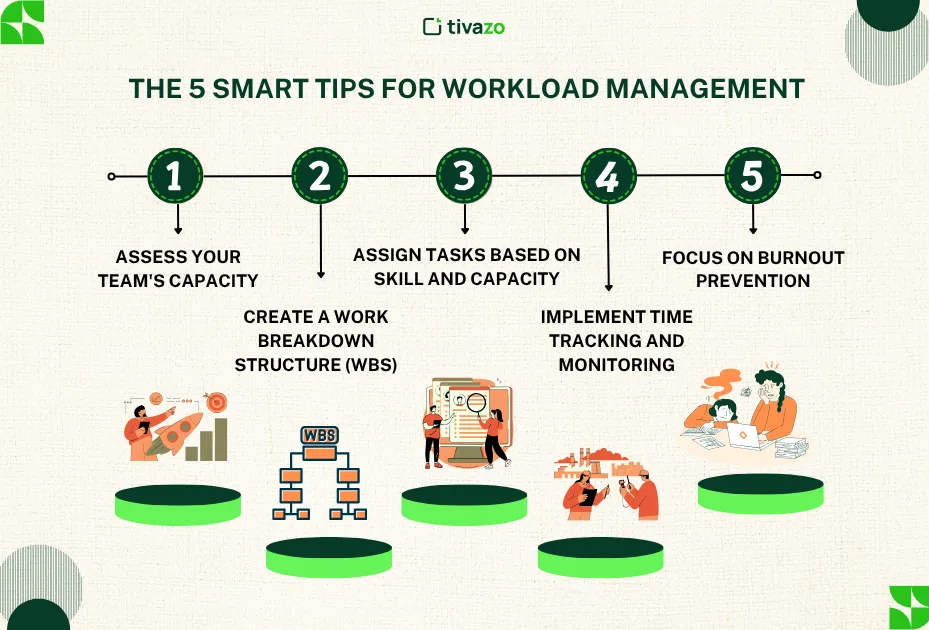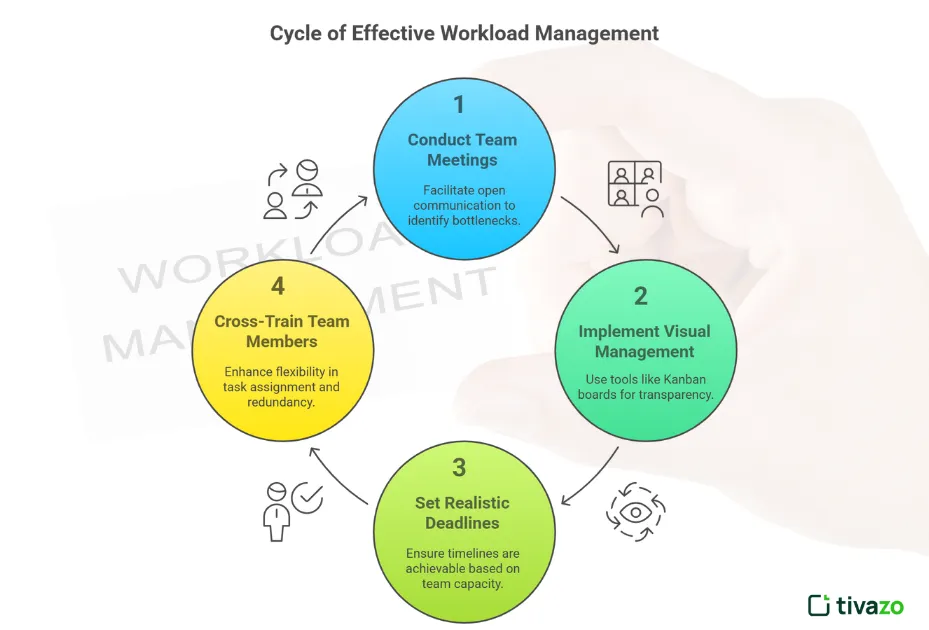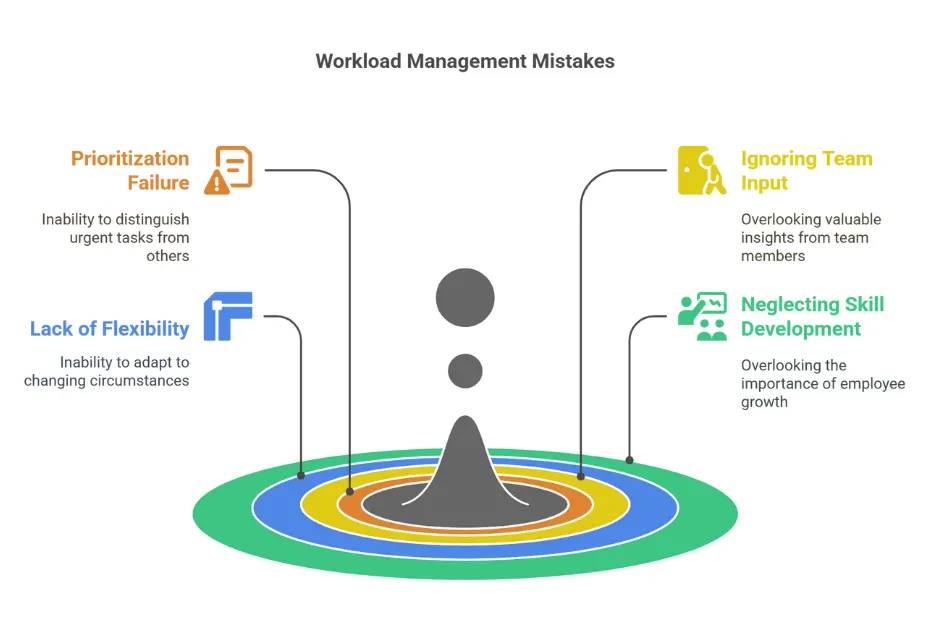Do you know that 76% of employees experience work-related burnout? Meanwhile, this shocking figure indicates a burning issue in the modern and dynamic working conditions. Inadequate workload sharing is not only a problem for personal lives, but it is also hindering team productivity and project completion rates.
The remedy is in the construction of an elaborate workload management plan beyond mere task allocation. By introducing a strategic workload management system, you will develop a system in which burnout is avoided and the potential of your team is brought out.
This guide will reveal to you five different strategies that effective teams employ in order to avoid overworking. The strategies will allow you to apply most of the available resources, better prioritize the tasks, and build a sustainable workplace environment where employees can flourish.
Are you ready to change the workplace handling of work by your team? So, let us jump into the strategies, which will change your workload management strategy.
What is a Workload Management Plan?
A workload management plan is a process of dividing the tasks and responsibilities with your staff based on capacity, character, and priorities. A well-organized system of workload organization is adaptable, as opposed to the usual arrangements of general tasks that usually cause confusion.
You can imagine that it is like a productivity GPS for your crew. A workload management strategy is to a work team as a global positioning system is to a car: It uses the load, abilities, and due date of the work to recommend the best distribution of work.
The main distinction between a successful and an unsuccessful workload management process is proactive planning versus reactive scrambling. Teams that lack an appropriate system are continuously in fire-fighting mode, resulting in missed deadlines, quality problems, and job burnout.
An effective workload management plan will turn all this madness into something systematic and predictable: the workflow. It guarantees that the work is evenly assigned, the deadlines are reasonable, and team members can work delivering high-quality results without being crushed with excessive stress.
The 5 Smart Tips for Workload Management

Tip 1: Assess Your Team’s Capacity
The next thing you should know before being able to manage workload effectively is to know your capacity. This is not merely figuring out hours, but it is a question of foreseeing how much an individual team member can realistically produce.
Begin with capacity planning that requires writing down these people and their availability, taking into consideration vocations, training, meetings, administrative work, etc. The error most teams have of 40 hours equalling 40 hours of productive work is when, in an actual sense, there are only 60-70 percent of productive time.
Enforce capacity reporting applications to offer real-time perspectives of workload distribution. Small teams can use simple spreadsheets, whereas larger organizations need to see how resources are used, which a special tool dedicated to project management can do automatically.
Capacity evaluations regularly enable you to flag up possible bottlenecks before they are actualized. Being aware of the actual capacity of your team, you will be able to make decisions regarding project schedules, as well as budget and resource allocation, accordingly
Tip 2: Create a Work Breakdown Structure (WBS)
The Work Breakdown Structure (WBS) is your secret key when it comes to the management of complex projects. It would allow turning monster projects into small, bite-sized pieces that your teams can take on one at a time.
First, list the principal deliverables and discard some of them as minor components. Repeat it until you end up with tasks that will take 1-3 days to complete. This micro level will make it more realistic to prioritize the tasks and avoid the scope creep.
Your WBS needs to contain the estimated time needed, dependencies between activities, and the skills needed. Such information is highly important when you are willing to delegate assignments according to ability and proficiency.
A WBS is visual, which assists team members in seeing the relationship between their tasks and the overall project, and makes team members more motivated and less fuzzy about what should be done next.
Tip 3: Assign Tasks Based on Skill and Capacity
Effective workload management is hinged on the smart assignment of tasks. Parceling out the job is not sufficient; you must also put the right person with the right Job and at the right time.
There are three areas that need to be considered when assigning a task: the level of skill, the number of assignments he/she is doing now, and areas of development. The best tasks must be allocated to team members who hold the correct skills and have the capacity to handle them. But never forget to mix difficult tasks with training opportunities for your team.
It is important to shun the pitfall of overloading your best performers. Although it is natural to want to assign key duties to top employees, such a strategy will result in stress and will cause unhealthy dependency. Rather, capacity planning should be utilized to provide a sustainable distribution of work.
Formulate a skills matrix that will include the capabilities of the team members with the requirements of the project. This graphical device simplifies the process of allocating work in terms of skill and capacity, and where possible, extra training may be necessary.
Tip 4: Implement Time Tracking and Monitoring
Proper workload management also implies constant monitoring and changes. The information that time tracking will give you would allow you to make intelligent capacity and resource decisions.
Install capacity tracking systems where the progress of a project and the workload of a team can be monitored on a regular basis. Check-ins may be weekly, and in the case of a heavily demanding project, every day might be required.
Find patterns and trends using this data. Are some kinds of tasks taking more time than intended? Does one team member have little capacity to complete his or her work, and the other has excess capacity yet nothing to do? This information will assist you in perfecting the workload management process.
Not only to gather information, but also to take action. The imbalances identified during monitoring should be addressed through assignment adjustments in advance of the escalation of problems.
Tip 5: Focus on Burnout Prevention
Prevention of burnout must become the primary objective of your workload management strategy. More than ensuring that you produce, you need to safeguard the welfare of your team to ensure sustainable productivity.
Catch on the red lights: falling quality, negligence of deadlines, growing absences, or altering any communication patterns. These are some of the signs that usually precede the outright statements of being overwhelmed by team members.
Plan cushion time in your timetables. Many times, it may be tempting to jam up schedules, but there is always the emergence of some sort of problem. Such surprises won’t create stress since you have a 15-20 percent cushion in your capacity planning.
Promote frequent breaks and attainable work-time-life limits. You cannot have a workload management system or tool that exhausts your employees and workforce.
Best Practices on Managing Workload to Make the Most of it

In addition to the five core strategies, there are other tips for effective workload management that successful teams use:
- Key Communication: Frequent team meetings will help to understand where bottlenecks are. When all people know and comprehend the workload management plan, collaboration will be enhanced spontaneously.
- Apply Visual management: Kanban boards and project dashboards open up the way work is shared with everybody. This openness aids your workload management policy as it would make everybody up to date.
- Keep Deadlines Realistic: Draconian time frames only turn out bad. Your plan must have plausible estimations depending on the capacity of a team and on previous experience.
- Cross-Train Members of a Team: Cross-training will allow you to have greater leeway with regard to assigning tasks to your team members. Such redundancy improves the system of workload management as a whole.
ProjectManager Tools in Managing the Workload
The appropriate tools enable contemporary workload management to become much easier. This is how to use technology to help with the workload management plan:
- Select the app: Whichever tool you apply, it is important that your platform has the options of capacity planning and resource management. The quality of the foundations of your workload management system determines the quality of the system.
- Automate wherever you can: Capacity monitoring and progress by setting up automated reports. This cuts down on administrative costs in your workload management strategy.
- Include Time Tracking: The tools, such as tivazo, Toggl, or an in-built time-tracking module, will help you determine the real working time compared to the estimated one. Such data increases the accuracy of future workload management plans.
- Design Templates: Consolidate an identical workload management exercise with project templates. This will create consistency in various projects and teams.
Common Workload Management Mistakes to Avoid

Even the teams that work with the best intentions are prone to making fatal flaws, which jeopardize the workload management strategy. The first mistake is that everything is considered to be a pressing task, and this kills off the successful prioritization of tasks.
The second common error is the inability to listen to the team’s opinion on the workload and capacity. Your subordinates can give you useful information concerning feasible schedules and personal scope boundaries. A good workload management system makes room to utilize their input regularly.
Most organizations also do not make the necessary plans when things change. Employment patterns of resources change, priorities are altered, and skills of team members are developed. This plan for your workload management must be flexible to accommodate these changes.
Lastly, never take skill development as a small consideration in your capacity planning. The team members who do not experience progress in their positions lose motivation, thus bringing the whole workload management plan down.
Conclusion and Next Steps
Developing a good workload management plan is not a one-time exercise, and it does not remain the same but continually changes as your team and projects do. The five strategies, which we have discussed, give a good basis for avoiding burnout and enhancing the performance of the team.
Take a slow approach to work on one of these tips during this week. It is more important to take action than to create something perfect with each step you take, so either start with a capacity assessment or develop your first Work Breakdown Structure.
It is important to remember that effective workload management is the balance between several aspects: the capacity of the working team, the development of skills, the prevention of burnout, and project objectives. Once you manage to strike this balance, you will notice that the satisfaction experienced by team members will improve, as well as the result of the project.
Workload management strategy will be one of the most important leadership tools that you will ever have, that will guarantee your team and organization a long-term, sustainable route to success.
FAQ
How to plan and manage workload?
An efficient way to deal with and schedule workload is to begin with a workload management plan. Divide the tasks into components, set them by urgency and importance, then assign resources based on team availability, and you can use such tools as ProjectManager to plan and equalize assignments.
How do you manage work overload?
Controlling work overload is possible only with the help of identifying workplace bottlenecks, delegating duties, and modifying the plan of workload distribution. Ensure that set deadlines are realistic, automate routine tasks and communicate openly with your team regarding capacity and expectation.
What are the three techniques of managing your workload?
The three tested methods of organizing your work can be summarized as:
- Prioritization of the tasks by means such as the Einstein Matrix
- Capacity planning with an organized workload scheme
- Time blocking to remain concentrated and evade multitasking
How to manage overworking?
In order to curb overworking, a balance plan of workload management should be incorporated with frequent breaks, redistribution of workload, and definite project timelines. Add time-tracking tools to keep track of the working hours and achieve sustainable productivity, with no burnout.




